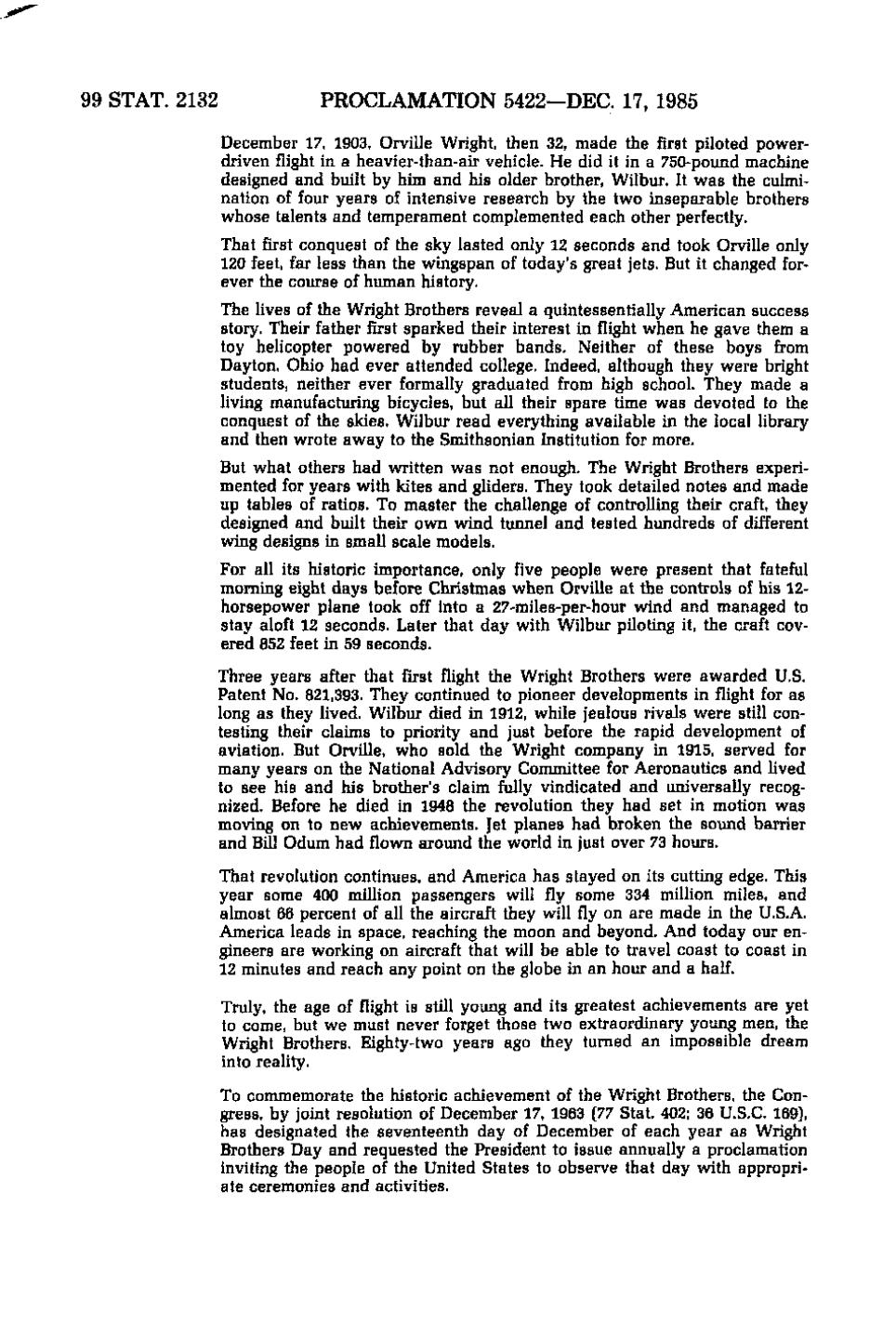99 STAT. 2132
PROCLAMATION 5422—DEC. 17, 1985 December 17, 1903, Orville Wright, then 32, made the first piloted powerdriven flight in a heavier-than-air vehicle. He did it in a 750-pound machine designed and built by him and his older brother, Wilbur. It was the culmination of four years of intensive research by the two inseparable brothers whose talents and temperament complemented each other perfectly. That first conquest of the sky lasted only 12 seconds and took Orville only 120 feet, far less than the wingspan of today's great jets. But it changed forever the course of human history. The lives of the Wright Brothers reveal a quintessentially American success story. Their father first sparked their interest in flight when he gave them a toy helicopter powered by rubber bands. Neither of these boys from Dayton, Ohio had ever attended college. Indeed, although they were bright students, neither ever formally graduated from high school. They made a living manufacturing bicycles, but all their spare time was devoted to the conquest of the skies. Wilbur read everything available in the local library and then wrote away to the Smithsonian Institution for more. But what others had written was not enough. The Wright Brothers experimented for years with kites and gliders. They took detailed notes and made up tables of ratios. To master the challenge of controlling their craft, they designed and built their own wind tunnel and tested hundreds of different wing designs in small scale models. For all its historic importance, only five people were present that fateful morning eight days before Christmas when Orville at the controls of his 12horsepower plane took off into a 27-miles-per-hour wind and managed to stay aloft 12 seconds. Later that day with Wilbur piloting it, the craft covered 852 feet in 59 seconds.
Three years after that first flight the Wright Brothers were awarded U.S. Patent No. 821,393. They continued to pioneer developments in flight for as long as they lived. Wilbur died in 1912, while jealous rivals were still contesting their claims to priority and just before the rapid development of aviation. But Orville, who sold the Wright company in 1915, served for many years on the National Advisory Committee for Aeronautics and lived to see his and his brother's claim fully vindicated and universally recognized. Before he died in 1948 the revolution they had set in motion was moving on to new achievements. Jet planes had broken the sound barrier and Bill Odum had flown around the world in just over 73 hours. That revolution continues, and America has stayed on its cutting edge. This year some 400 million passengers will fly some 334 million miles, and almost 66 percent of all the aircraft they will fly on are made in the U.S.A. America leads in space, reaching the moon and beyond. And today our engineers are working on aircraft that will be able to travel coast to coast in 12 minutes and reach any point on the globe in an hour and a half. Truly, the age of flight is still young and its greatest achievements are yet to come, but we must never forget those two extraordinary young men, the Wright Brothers. Eighty-two years ago they turned an impossible dream into reality. To commemorate the historic achievement of the Wright Brothers, the Congress, by joint resolution of December 17, 1963 \J7 Stat. 402; 36 U.S.C. 169], has designated the seventeenth day of December of each year as Wright Brothers Day and requested the President to issue annually a proclamation inviting the people of the United States to observe that day with appropriate ceremonies and activities.
�
